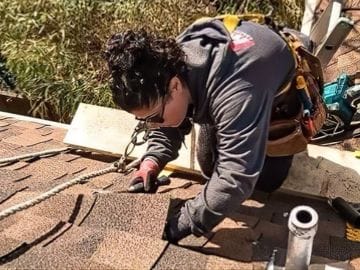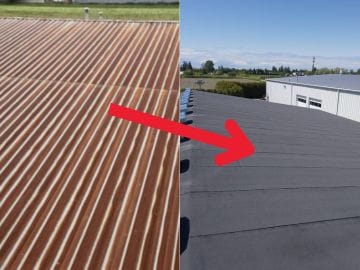Back in the 1990s, concrete tile roofs became a popular roofing material for executive-style homes being built at the time.
Concrete roof tiles became popular
Cedar roofs had proven to be not as long-lasting as everyone had hoped, seeming to wear out in only 15 to 25 years when their life expectancy should have been closer to 35 years.
Everyone loves the look of a new cedar roof. It is warm and rich. It is definitely a fashion statement. But the heavy expense of reroofing every 15 to 25 years, a roof life less than one would get from an inexpensive asphalt roof, is not a sound financial decision for most.
Concrete tile roofs at the time were hoped to be a solution to a longer-lasting, good-looking roof. They are thick, have a great texture, and give great curb appeal to a home with an obvious architectural style. They after all have a proven life expectancy in many European countries, with a similar climate to us, of 50 to 70 years.
So, as a result, thousands upon thousands of new homes were given concrete tile roofs to meet the demand for a nice stylish architectural style for better homes, that hopefully lasts a long time.
But there are now problems
If you have a concrete tile roof, how is it holding up today? Are tiles falling out of position or cracking? Water leaking around flashings and roof details or at the eaves is water getting behind the fascia board and gutters?
Sadly, this is the case for many homes today with concrete tile roofs. How could this happen?
Well, it goes back to the fact that while such roofs were proven to last 50 to 70 odd years in Europe, those roofs were installed with much better roofing practices and workmanship techniques than here.
Why haven't they lasted?
Here is a list of the issues we have found with concrete tile roofs in the Lower Mainland.
- Most tile roofs around this region (98 %) were installed over open trusses.
- The underlayment was draped over the open trusses, dropping roughly ¾" down in the spaces between each truss, and the all-important backup system to the tile layer.
- With this non-plywood system, the builders saved money, and the cost difference between tiles and cedar was diminished, giving tiles an advantage.
- There realistically were no proper roof inspections ( if any ) being performed by the City Inspectors back them, nor most builders.
- The builders generally asked a roofer ... I need a tile roof ... what is your price? With no scope of work or builder's specifications, the roofers began to scrimp and "cheat" and do poorer quality work, without the needed better workmanship and proper assembly and without the better details and roof accessories. Low-price won, and quality really, really suffered.
- Unfortunately, the work to waterproof skylights, chimneys, vents, pipes, and fittings on the roof was not completed well and is now the biggest issue with tile roofs.
- It is exceptionally difficult to create permanent seals into hanging underlayment around any roof penetration, with open trusses, and non-plywood-based roof substrates.
- The underlayment gets brittle over time when hanging over trusses, and can fail easily after twenty years.
- The underlayment often sags behind the bottom eave fascia and does not deliver the rainwater into the gutters. The roofs often did not install anti-ponding metal flashings.
- The tile roof finishes are needing resealing or recoating, and often require roof cleaning to start that extra process.
- The roofs were often under-vented, which negatively affected any existing insulation, and sometimes caused Mold and deterioration of the interior of attic framing.
Can you repair existing tile roofs?
The short answer is yes. However, it is extremely difficult, and expensive to attempt to improve the roof system.
Our team of roof technicians must first find matching tiles, as doing repairs often leads to some tile breakage, and all local tile manufacturers are no longer in business. They also need to take apart some of the wood strapping, to get to the underlayment layer which is not performing. They may need to add plywood around skylights and chimneys, and other large roof penetrations, to make a solid deck to apply waterproofing around these critical areas.
Tile roof repairs, if completed properly, are very expensive, and there is no warranty available for repairs to a roof (only for full new roof applications ). Plus, in the end, when we do not rebuild entire faces of roofing, it is not a reliable solution to protect your home.
Asphalt fibreglass shingles are now the better option
Often, at 25 years plus tile roof age or older, it is much more effective to proceed with a complete reroof, and convert the roofing material to a mid-weight or heavier weight asphalt fibreglass shingle system, or for some, for additional investment, change the roof to a metal roofing system.
Most homeowners select an asphalt shingle as the new roofing material. Unfortunately, some do not realize that installing a cheap, thin asphalt shingle will 'cheapen' the look and style of the home and make it lose its 'executive-class' architectural style.
We recommend that homeowners select heavier weight and thicker styles of asphalt fibreglass laminated shingles. They have much-improved texture and style, especially for replacing concrete roof tile roofs.


















